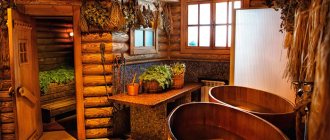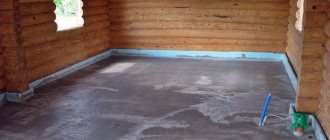The bathhouse is a place for healing and relaxing procedures.
The unique properties of the steam room have been known for a long time - rapid warming up of the body, strengthening the immune system, fighting various diseases. Many bathhouse attendants are interested in a very pressing question - how to make a pleasant smell in the bathhouse in order to relax with benefit for the soul and body?
The simplest and most affordable method of aromatherapy for a bath is to use essential oils, herbal mixtures and tinctures. It is very important to adhere to a strict dosage and use them correctly without harm to human health.
How do bath infusions work?
A distinctive feature of the Russian bath (besides the use of a broom) is the indispensable presence of certain healing aromas in the hot atmosphere of the steam room. They densely saturate the air with intense evaporation of infusions or decoctions of various herbs and plants rich in essential oils. A small amount of infusion is periodically sprinkled on well-heated stones of the sauna stove, or it is poured into special devices - aromatizers. An infusion differs from a decoction in that fresh or dried herbs are simply poured with warm or hot water (according to the recipe) and left for the required time (infused), but the decoction still needs to be boiled over a fire. And in their effects they are almost identical.
The therapeutic effect of infusions is achieved due to the effect of inhalation of the respiratory system with hot vapors of essential oils. Beneficial substances are absorbed into our blood through the lungs and mucous membrane of the nose and throat and, with its help, are distributed throughout the body and delivered to each individual organ. But even this important factor does not limit the usefulness of herbal infusions. No less effective is their external effect on our skin and hair, sometimes helping to overcome quite serious diseases. In Rus', since ancient times, herbal infusions in the steam room have successfully treated not only colds, lungs and bronchi, but also numerous skin diseases: rashes, acne, redness.
Natural essential oils
Aromatherapy in baths and saunas has a beneficial effect on all systems of the human body. Soft and clean steam containing aromatic oils helps prevent and treat various respiratory diseases.
Natural aromatic oils effectively saturate the bath air with beneficial compounds that actively penetrate the human body through the respiratory system and skin.
Essential oils in baths and saunas have the following beneficial characteristics:
They have metabolic, trophic, secretory, training and diaphoretic effects. Used for inhalation, massage, rubbing and baths.
Oils for saunas and baths, depending on their composition, can have a comprehensive healing effect on the body.
- Juniper, anise and dill oils are used for coughs and congestion in the upper respiratory tract.
- Eucalyptus and peppermint oils have a powerful antiseptic effect, so they are used for colds.
- To treat headaches and normalize blood pressure, it is better to use verbena and geranium oil.
- For muscle and emotional stress, you can use geranium, wormwood and lemongrass oil.
- If you lack strength and are tired, it is better to choose rosemary and rose oil.
- To treat skin diseases, it is recommended to use sedative and wound-healing essential oils for baths and saunas - chamomile, sage, valerian, sea buckthorn and pine. In addition, such oils tone and increase skin elasticity.
- Coniferous oil for saunas and baths - spruce, pine, fir and cedar - has a powerful antibacterial and anti-inflammatory effect. Such oils are best used as quick septic tanks for healing damaged skin.
- Air saturated with aromatic oils promotes detoxification and cleansing of the body. The best natural flavors for a bath are lemon, sandalwood and juniper oils.
What herbs are used for infusions
The list of plants whose leaves, flowers or fruits are used for bath infusions is almost endless. If you try to list the weight, you will get a voluminous book (and such a book probably exists). The most common and famous are the following plants and herbs: eucalyptus, juniper, birch, hawthorn, linden, thyme, coltsfoot, motherwort, calendula, yarrow, caraway, St. John's wort, oregano, sage, rowan, oak bark, sweet clover, chamomile, wormwood, lavender, etc.
Each of them can be used separately, but more often they are used in the form of mixtures in various combinations. Species with approximately the same medicinal properties are purposefully selected, trying to obtain a greater total effect than from each component separately. Combinations of herbs with opposite effects on the body, for example, a calming and tonic effect (St. John's wort with wormwood, oregano with cumin, etc.) are excluded. And for the rest - the widest opportunities for your creativity, testing various combinations and proportions, taking into account both medicinal and aromatic properties that are pleasant to you personally.
Spiraea
This plant has a pleasant honey aroma and is most often combined with oak. Meadowsweet infusion is used to make lotions to relieve joint pain. The plant effectively fights tumors, ulcers and burns, helping to accelerate wound healing.
Meadowsweet decoctions are the best remedy against headaches and skin problems. They also have a thinning property, which makes them indispensable for increased blood clotting.
In addition, meadowsweet is known for its antidiabetic, calming and anti-cold effects.
Indications
How to choose the most useful and effective bath infusion recipe for yourself?
Let's try to tabulate our version of infusion recipes for a specific physical state of the body and individual diseases.
| Illnesses or disorders in the physical and emotional state | Recommended plant species |
| Hypertensive diseases | Motherwort, hawthorn, wild rosemary |
| Anxiety, overexcitation, insomnia | Oregano, St. John's wort, thyme, hops |
| Loss of strength, apathy, requiring stimulation of internal energy | Wormwood, caraway, rowan |
| Muscle fatigue from hard physical work or sports training | Mint |
| Disorders of the nervous system | Juniper, fir, pine, spruce |
| Diseases of the lungs and bronchi | Linden, coltsfoot, sage |
| Cold | Sweet clover, thyme, eucalyptus |
| Disturbances in the functioning of blood vessels and capillaries, in metabolism, stabilization of blood pressure | Lavender |
| Skin rashes, acne, eczema and other skin inflammations | Oak bark, chamomile, yarrow, poplar, calendula, juniper |
Contraindications
There are some diseases for which you should not use bath infusions:
- diseases of the cardiovascular system;
- angina pectoris;
- It is not recommended to take a steam bath at the height of viral diseases, when the body is weakened;
- if you have epilepsy, steam rooms should be avoided;
- for diseases of the spinal cord and brain, you should consult a doctor;
- It is not recommended to use baths for health purposes for pregnant and lactating women, as well as children.
Before using bath infusions, it would be a good idea to make sure there are no allergies and consult a doctor.
Preparation of bath infusions
You prepare the simplest bath infusion, perhaps without thinking about it, when you steam a broom. The water obtained from the steamer can be used with great benefit by spraying it onto the heater and the walls of the steam room. And if you steamed several different brooms at once (for example, birch, oak and juniper), you can create a polyphonic symphony of various aromas in your steam room. But this recipe is good for beginners who are just starting to learn the basics of bath culture. People with experience prefer to prepare bath infusions in advance and specifically for themselves from herbs that meet their medical indications. Nowadays there are a huge variety of herbal mixtures for bath infusions, decoctions and steamings on sale, and many people use just such ready-made preparations. The packages contain indications for use and indicate the method of preparation: what water to take, how much greenery to add, how long to stand, etc. Very convenient and no headaches.
However, especially advanced bath lovers will always prefer their own herbal infusions, prepared with their own hands, over purchased ones. They are considered healthier than store-bought ones (not without reason). What you need to know to prepare herbs (fruits, seeds) for infusions according to all the rules:
- Firstly, it is very important to know the exact timing of harvesting a particular crop; the content of essential oils in the green mass or fruits depends on this;
- Secondly, the raw materials must be thoroughly dried naturally in a dry, shaded and ventilated room (in the attic, in the barn);
- Thirdly, the dried raw materials must be properly crushed: leaves and flowers to a particle size of 0.5 cm, roots, stems and bark to 0.3 cm. Seeds and fruits are pounded with a pestle in a mortar to the size of semolina;
- Fourthly, raw materials should be stored in a cool, dark place in containers with tightly sealed lids. It is preferable to store each type of plant in a separate container, and mix them in the required proportion immediately before preparing the infusion;
- Fifthly, each container should be provided with a label indicating the type of plant and the harvesting date in order to know the expiration date. Herbs, flowers and leaves do not need to be stored for more than 2 years - they will lose their beneficial properties. But the shelf life of seeds, fruits and berries is longer - 4 years.
And now you are going to the bathhouse. Take your wealth out of the jars, measure out the required amount of each ingredient and place it in a gauze bag. Using this bag you will prepare the infusion by placing it in a glass or enamel bowl and pouring hot water. Be sure to cover with a lid to prevent the water from cooling down too quickly. For most herbal infusions, 30 minutes is enough to achieve condition, but there are components (containing fruits, bark, roots, etc.) that need to be infused for several hours. Therefore, the infusion is prepared in advance.
We got ready for the bathhouse in the evening (it also needed to be heated) - in the morning we poured the grass to steep. But you shouldn’t fuss too much in advance: the finished infusion should not be stored for more than two days - it will lose all its usefulness. During this period it is permissible to store it, but only in a cool room and under a lid. And do not forget to strain the infusion through double gauze before drinking. It will be unpleasant if even the smallest particles of grass get on the heater and start to burn. The infusion must be clean. Enjoy your bath! With a light and healthy steam!
What it is
Medicinal herbs have long helped our ancestors cope with various diseases. One of the effective ways to use them is to prepare steaming teas for a bath. This name was given to the powder from dried medicinal herbs. Zaparki is prepared in the summer and stored in fabric bags.
Our ancestors used a slightly different version of steaming - bunches of herbs that were stored suspended in the attic or barn. The herbs were brewed with boiling water, and the broth was splashed onto a hot stove or stones. During evaporation, the air was filled with various substances that produced the desired effect.
Today, it has become inconvenient to store herbs for baths in the form of bunches, so they began to chop them up and package them in small bags. This is how the bathhouse steamer appeared. Unlike infusions, steaming is stored in dried form for quite a long time, and before visiting the bathhouse it is brewed with boiling water.
Independent procurement of raw materials
In order to independently prepare medicinal herbs for further use, you must have certain knowledge in this area. To collect plants you need to consider:
- The area where the desired variety of grass grows. A prerequisite is its remoteness from public roads and industrial facilities.
- Properties of each plant, what it is used for.
- Botanical features: time of flowering, ripening, fruiting.
- Collection period to achieve maximum effectiveness from use.
Once the herb is harvested, it must be dried properly. This is carried out in well-ventilated areas without direct sunlight. Next, the raw materials are crushed and stored in glass containers. The prepared raw materials retain their beneficial properties for 2-3 years. Pack in bags immediately before use. All prepared steams are used once, but bags made from natural fabrics can be used several times.
Herbal variety
First of all, we need to decide which medicinal plants deserve our attention. Here various medical reference books on the therapeutic and preventive properties of herbs will come to our aid.
The most commonly used types in the bath include:
Note! This property of hops is often used by athletes during training.
In addition to these plants, you can also use horseradish (used for compresses), black currant, spruce, pine or fir needles, valerian, yarrow... It’s probably impossible to list all the herbs.
As was said at the beginning, it is best to collect the herbs yourself. However, if you cannot find the plant you need, you can always buy it at the pharmacy - fortunately, the price of medicinal raw materials is quite affordable.
Natural flavors and additives
With the right approach, you can get therapeutic steam with any aroma in the steam room by adding natural flavors and additives to the water.
The classic aroma of a bathhouse is the bready aroma exuded by kvass or beer. Such drinks are infused with bread crumb and malt. Another natural flavoring for saunas and baths is honey, which will fill the room with the amazing smell of a field apiary.
Lovers of forest walks can choose spruce or fir flavors - the steam acquires a rich aroma of pine needles. Mint and lemon balm aromas help relieve physical fatigue and stress. Exciting aromas of rose, sandalwood, ylang-ylang, orange and lemon can give vigor and confidence, lift your spirits and improve your well-being.
A good alternative to drug treatment for colds is to use mustard powder to produce medicinal steam. Some bath attendants will like the smells of melons - melon or watermelon, while others will not refuse the aroma of ripe cherries or peach.
A garlic bath is completely unusual for lovers of spicy aromas and piquancy. Garlic steam has a powerful antiseptic effect on the upper respiratory tract, so it is especially useful for colds.
Creating a fragrant atmosphere in a bathhouse is a serious and responsible process. To ensure soft steam and benefit from wellness treatments, it is important to know how to use natural oils, herbal infusions and flavors, purchased at the pharmacy or made by yourself.
Source











